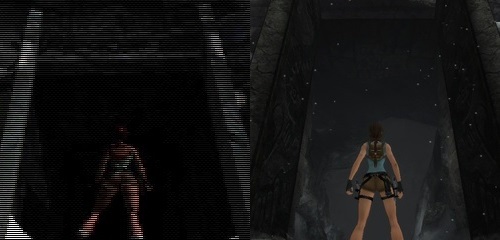
Total Conversion:
Tomb Raider vs. Tomb Raider Anniversary
|
<<< Prior Page |
|
Page 1: |
Page 2: |
Page 3: |
Page 4: |
Page 5: |
|
Page 6: |
Page 7: |
Page 8: |
 |
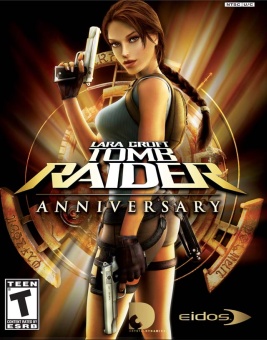 |
|
Few video game series have experienced as many ups and downs as Tomb Raider. After the seminal original in 1996, developer Core Design was quickly railroaded into annual sequels, which worked out great at first but eventually led to a drop in quality and stagnation in an engine that didn't see much evolution over five long years. Core Design finally tried to take Tomb Raider into a new direction with the spectacular failure Angel of Darkness, which resulted in the series given into the hands of Crystal Dynamics and started from scratch. Crystal Dynamics went on to reinvent the franchise with almost every other new entry, but in 2007 - oddly not ten, but eleven years after it all started - they decided to return to Lara's first adventure with Tomb Raider Anniversary, giving it a modern makeover in the engine of their own debut Tomb Raider Legend. With the release of Rise of the Tomb Raider, which promises again a return to the virtues of the series' roots, it appears high time to take a look back at how exactly Tomb Raider was modernized for a 2007 audience. While it remains to be seen if a game with its structure could have at all a place in the video game land scape of today, one cannot help but wonder how much of it would change in a "Tomb Raider 20th Anniversary". Aside from the many beat-by-beat changes that are going to be explored below, Anniversary of course takes a drastically different approach to controls and interface. In 1996, "tank controls" were the standard solution to movement in a three-dimensional space. While the up and down directions make Lara dash forward or hop backward, left and right make her slowly turn around her own axis. The modern equivalent in Anniversary makes Lara run immediately in the pressed direction relative to the camera, which feels much more fluid and natural, but also comes with a share of new problems. The reliance on camera position makes for a lot of cheap deaths because the camera turned in the middle of a sequence and the game interprets directions differently than intended by the player. The tank controls, while clumsy, made sure the exact same input always brought the exact same results, turning the game into a methodical exercise in counting steps and timing jumps, much like the original Prince of Persia that inspired the game so much. Definitely in Anniversary's favor is the much expanded variety of moves. In the original Tomb Raider, her climbing abilities are limited to hanging onto ledges to either pull herself up on the above platform or shimmy along to either side. Crystal Dynamics included many of the more dynamic elements from Tomb Raider Legend, such as horizontal poles to swing on, vertical pillars for Lara to balance on the top and jump from pillar to pillar, and last but not least her grappling hook that can be used as a makeshift swing or wall run assist wherever the necessary installations to hook into are present. Lara also learned to hold onto ledges and poles automatically (well, most of the time), leaving the player free for more pressing tasks - such as wrestling with the obstinate camera. When Lara just barely manages to hold onto something, she is still in danger of falling down and requires a quick saving button press, signified by a yellow warning sign. While Lara automatically aims at approaching enemies in 1996's Tomb Raider, there is no way for the player to influence which attacker she is targeting. Anniversary adds that function as well. The automatic aiming doesn't work as reliably as it used to, but there is also a handy manual aim, although the latter significantly impairs her maneuverability. When shooting at the same animal a lot, it now falls into a raging frenzy, which Lara can counter by doing a save roll as time slows down for a brief moment, waiting for two crosshairs to meet at the enemy's head and then pull the trigger to kill them instantly. It's a bit silly that the attacker turns invincible during the rage, no matter how little health it has left. Another signifier of the changes in game design is the save system. The original console versions of Tomb Raider had "save crystals" floating around at specific spots to save the game in the middle of a stage. They were sometimes pretty far away from each other, following a failure and repeat structure that had been dominating action games since the early 1980s. The PC version allowed saving anywhere, which made it easy to "lock in" any progress no matter how minute, but also carried the danger of saving in unwinnable situations. The remake throws both approaches out the window and instead enforces a modern autosave checkpoint system for all platforms, PC included. This means players never have to worry about losing progress because they forgot to save the game, and the next checkpoint is usually not very far. On the downside, there are still many instances where the checkpoints force Lara to repeat dull easy fights before tricky platforming segments over and over again, and there is no safe way to do some stupid experiments and then reload. On the other hand, there is no point in doing that any more anyway, as hardly anything the player does has any consequences. When dying, Lara always restarts with full health at the last checkpoint, rendering health kit management completely unnecessary and leaving her with a surplus of several dozen by the end of the game. |
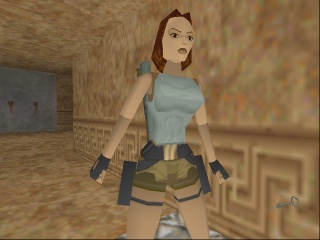 |
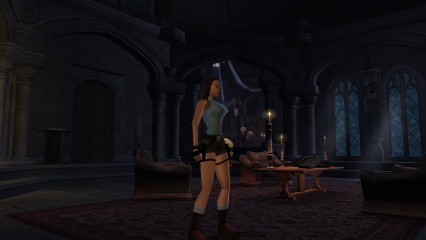 |
|
Aside from her outfit in the Croft Mansion training level, Lara used to wear the same clothes all throughout her first adventure. Every sequel added more costume changes for Ms. Croft, but in the classic games those were always tied to the mission at hand. Anniversary allows unlocking several costumes by finding relics, which can then be chosen freely by entering the mansion at any time. One of them is labeled "Classic" and uses a low-polygon model, although it is distinctly not faithful to the actual model used in the original game. The most noticeable differences are an extra polygon or two to round out Lara's once perfectly triangular chest a little, the hair and the lack of abdominal muscles showing through from underneath her top. |
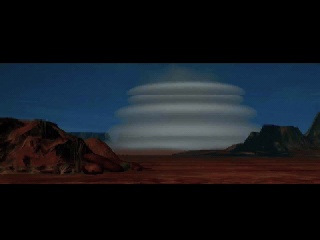 |
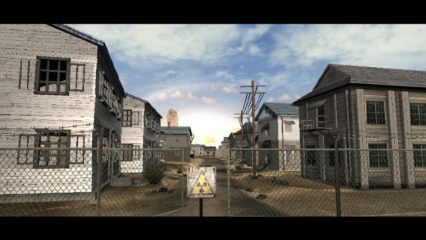 |
 |
 |
|
Both games start with a bang - a huge explosion in the desert. Whereas the original just had a nondescript detonation in the middle of nowhere, the remake actually shows a nuclear explosives test site, complete with a fake village that is about to be torn down by the impact. In both cases the explosion unearths a mysterious creature, although it's still locked in crystal in the old game, but running free in Anniversary. |
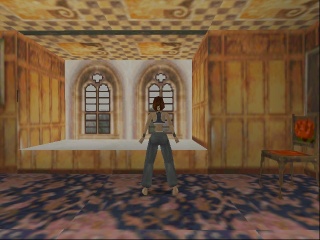 |
 |
|
Croft Manor underwent some serious renovation for the remake. Lara starts out in the main hall, instead of her master bedroom. The whole map has been repurposed from a basic tutorial to a full stage of its own, with secrets, a series of puzzles and a goal. There's also a ton of books of cultural history trivia lying around, some of which contain allusions to Lara's "past" adventures, others foreshadowing for the upcoming quest. |
 |
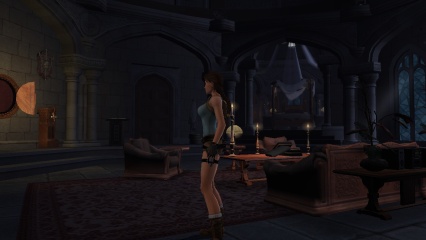 |
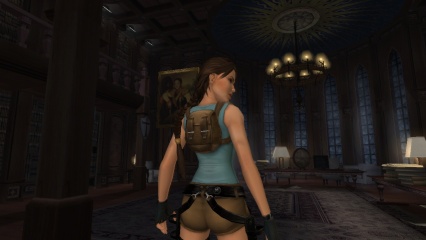 |
|
Originally the master bedroom just consisted of a single room that also included the library, and three of the four doors in the upper story were locked permanently. Now the bedroom alone consists of two rooms and a walk-in closet (where it's possible to chose from several unlockable costumes), and the now separate library spans two large rooms as well. |
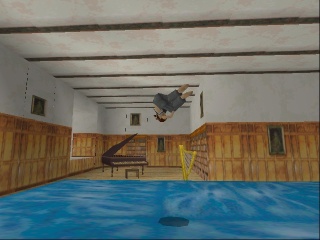 |
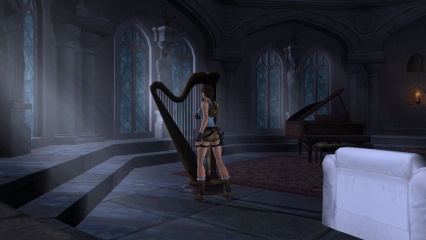 |
|
Lara had repurposed the music room into a mini-gym, with only some instruments shoved into the corner. Reaching the octangular room is the goal in the remake, here Lara can play some notes on all the instruments, or chose unlocked music tracks from the game on her stereo. |
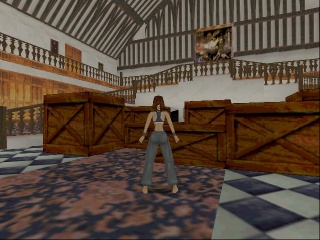 |
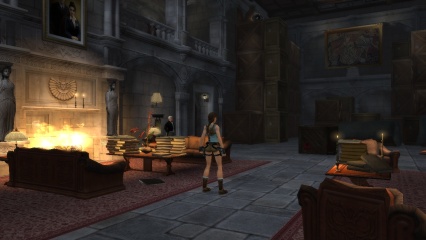 |
|
The main hall now serves as a proper living room, although there's still a bunch of crates in the corner, which were all that was there in the original - save for the Ark of the Covenant, which used to stand there inconspicuously, but is now gone. As can be seen on the screenshot, the butler now also follows Lara around some rooms, which was a feature first added in Tomb Raider 2. |
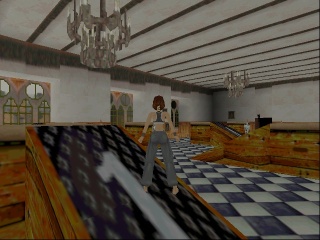 |
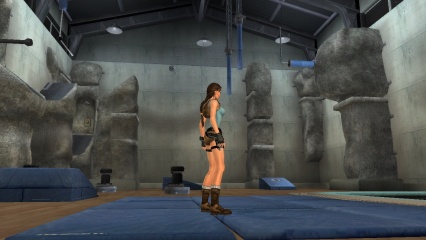 |
|
Lara had turned the former ball room into her main gym to practice all kinds of jump maneuvers. In the original, it's just a bunch of ramps and boxes, but gets turned into an impressive installation of climbing walls, mats and poles, to account for all the new moves added to the game. There are no traces of a ballroom left. |
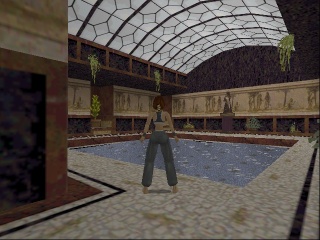 |
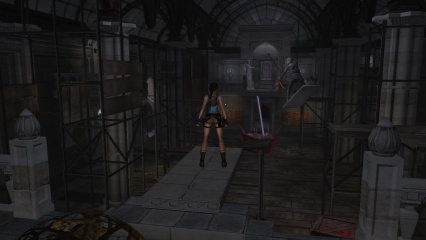 |
|
The pool is the only part in the house that's in better shape in the original, where it's actually usable. In the remake, it's just one huge, messy construction site for what admittedly would become a much larger pool area. |
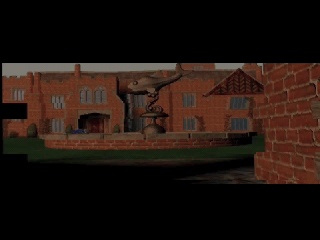 |
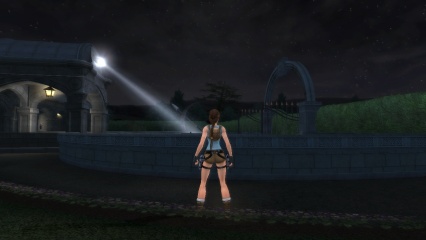 |
|
When Tomb Raider was first released, the outside of the mansion was only ever seen in a FMV zooming in on the bedroom window before taking control of Lara. Now there's a whole new section of the garden, complete with a hedge maze! It's also notable that the stage takes place at night, while the windows in the original showed some bright-ish foggy backdrop. |
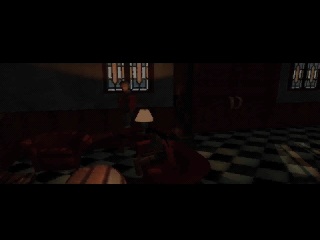 |
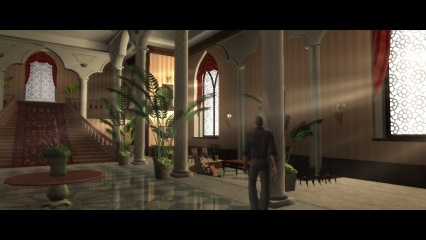 |
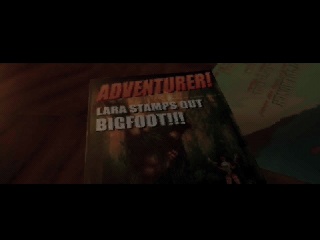 |
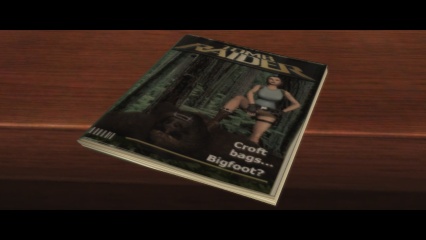 |
 |
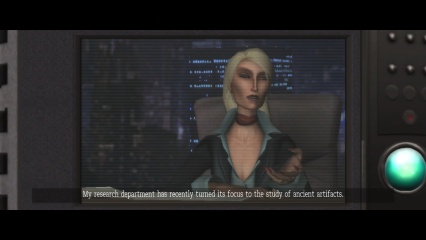 |
|
After the short teaser-style introduction (the mansion is always optional), a proper narrative intro video kicks off the actual adventure. By now another major difference becomes evident: In 1996, Core design delivered all cutscenes as FMV sequences, complete with crappy scanlines in the PC version (which is why the thumbnails are looking so dark), which the remake replaces with in-engine cutscenes. Natla's henchman Larsson approaches Lara in a grander hotel lobby, and while the dialog is fairly similar, Lara now actually recognizes Larsson, and already doesn't like him. The magazine he hold in front of her is now named Tomb Raider instead of the more generic but less fourth-wall breaking Adventurer!, and the cover got a funny change in tone. Natla's silly (but hardly recognizable) gesture where she left dollar notes floating in the background is gone, and she's shown in closeup on the laptop screen. The plot also gets more involved than just "fetch that random ancient artifact you know nothing about," as it is now the continuation of an expedition to which Lara had accompanied her late father, who had been retconned as a distinguished archaeologist since Tomb Raider Legend. |
|
<<< Prior Page |
|
Page 1: |
Page 2: |
Page 3: |
Page 4: |
Page 5: |
|
Page 6: |
Page 7: |
Page 8: |